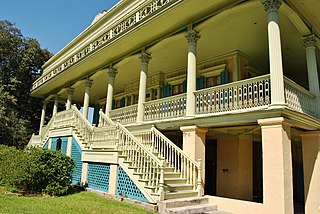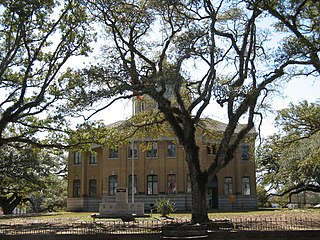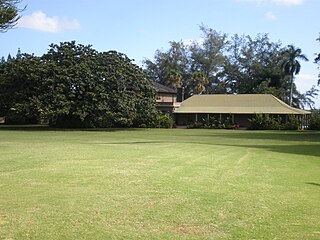
St. John the Baptist Parish is a parish located in the U.S. state of Louisiana. At the 2020 census, the population was 42,477. The parish seat is Edgard, an unincorporated area, and the largest city is LaPlace, which is also unincorporated.

Natchitoches is a small city and the parish seat of Natchitoches Parish, Louisiana, United States. Established in 1714 by Louis Juchereau de St. Denis as part of French Louisiana, the community was named after the indigenous Natchitoches people.

Woodville is one of the oldest towns in Mississippi and is the county seat of Wilkinson County, Mississippi, United States. Its population as of 2020 was 928.

Church Hill is a small unincorporated community in Jefferson County, Mississippi, United States. It is located eight miles east of the Mississippi River and approximately 18 miles north of Natchez at the intersection of highway 553 and Church Hill Road. Church Hill was a community of wealthy cotton planters and enslaved people before the American Civil War. Soil erosion, which had been going on since well before the Civil War, caused the area to decline into a poor farming community with none of the land under cultivation by 1999. The area is remarkable because its antebellum buildings are mostly intact with few modern buildings having been built.

The Kate Chopin House, also known as the Bayou Folk Museum or Alexis Cloutier House, was a house in Cloutierville, Louisiana. It was the home of Kate Chopin, author of The Awakening, after her marriage.

Oakland Plantation, originally known as the Jean Pierre Emmanuel Prud'homme Plantation, and also known as Bermuda, is a historic plantation in and unincorporated area of Natchitoches Parish, Louisiana. Founded as a forced-labor farm worked by enslaved Black people for White owners, it is one of the nation's best and most intact examples of a French Creole cotton plantation complex. The Oakland Plantation is now owned by the National Park Service as part of the Cane River Creole National Historical Park.

The Butler Greenwood Plantation is a plantation in Louisiana. It is on U.S. Route 61, 2.2 kilometers (1.4 mi) to the north of St. Francisville, Louisiana. It is listed on the National Register of Historic Places.
Inglewood Plantation Historic District is located in Rapides Parish, Louisiana about 6 miles (9.7 km) south Alexandria, Louisiana. It was added to the National Register of Historic Places on January 14, 1988.

McNutt Rural Historic District is located in Rapides Parish, Louisiana around the intersection of Belgard Bend Rd. and Louisiana Highway 121 that make up the rural community of McNutt, Louisiana. It was added to the National Register of Historic Places on September 15, 1988. McNutt is named from "McNutt Hill," itself named for Isaac McNut], the son-in-law of John Texada, a federal land agent in the area in the early 1800s.
Thomas William House Sr. was a merchant and cotton factor in Houston, Texas. He also invested in and organized transportation and utility companies in the Houston area. He was a veteran of the Texas Revolution and provided financial assistance to the Confederacy during the American Civil War. He was mayor of Houston, Texas in 1862.

Grove Farm is a historic agricultural site on Kauai in the Hawaiian Islands.
The 3rd Rhode Island Cavalry Regiment was a cavalry regiment that served in the Union Army during the American Civil War. The regiment briefly served dismounted as infantry in the defenses of New Orleans, June–September, 1864.

Allen Thomas was a Confederate States Army brigadier general during the American Civil War. He was born in Howard County, Maryland, and became a lawyer but he moved to Louisiana in the later 1850s and became a planter and colonel in the Louisiana militia. After the war, he was a planter, Presidential elector in 1872 and 1880, professor of agriculture at Louisiana State University and coiner at the United States Mint at New Orleans, Louisiana. He moved to Florida in 1889. Between 1894 and 1897, he was United States Minister to Venezuela. He moved to Mississippi in 1907 and died there in that year. He was buried at Donaldsonville, Louisiana.
Leon Godchaux was a French-born American businessman, planter, sugar plantation owner and the founder of the Leon Godchaux Clothing Co. department store and Godchaux Sugars Inc.. He lived in Louisiana, where the "largest sugar plantations" were "the Calumet, and those owned by Leon Godchaux, 'The Sugar King of the South.'"
Joseph Emory Davis was an American lawyer who became one of the wealthiest planters in Mississippi in the antebellum era; he owned thousands of acres of land and was among the nine men in Mississippi who owned more than 300 slaves. He was the elder brother of Jefferson Davis and acted as his surrogate father for several years. The younger Davis became a politician, U.S. Senator, and later President of the Confederacy.
William Prince Ford was an American Baptist minister, preacher and planter in pre-Civil War Louisiana. He was the slave owner who first bought Solomon Northup, a free African-American, after Northup had been kidnapped in Washington, D.C., and sold in New Orleans in 1841. He resided in the "Great Pine Woods", Avoyelles, Red River Parish, Louisiana, and he ran a farm there. At the same year, Ezra Bennett, a Bayou Boeuf storekeeper and planter, lived near the plantation of Prince Ford and gave him instructions to his factors.
Abijah Hunt (1762-1811) was an American merchant, planter and banker in the Natchez District.
The Acadia Plantation was a historic plantation house in Thibodaux, Louisiana, U.S.. It was the plantation of James Bowie, Rezin P. Bowie, and Stephen Bowie. James "Jim" Bowie, served in the Battle of the Alamo. It was listed on the National Register of Historic Places on May 29, 1987. It was demolished in 2010.

Bayou Boeuf Elementary School (BBES) is an elementary school in unincorporated Lafourche Parish, Louisiana, east of the Kraemer census-designated place. It serves residents of the Ward 6 Area of the parish, including Bayou Boeuf and Choctaw. It is a part of Lafourche Parish Public Schools.

Edwin Epps House is a Creole cottage built in 1852 in part by Solomon Northup on Bayou Boeuf near Holmesville in Avoyelles Parish, Louisiana. It was built for Edwin Epps, a slaveholder. The house was a "double-sided, wood frame house with one chimney, and a tin roof" of mid-sized farmers. The Edwin Epps Plantation Site, where the house originally stood, is located off of LA 1176 on Carl Hunt Road. It is one of the historic sites of Solomon Northup's enslavement on the Northup Trail.













